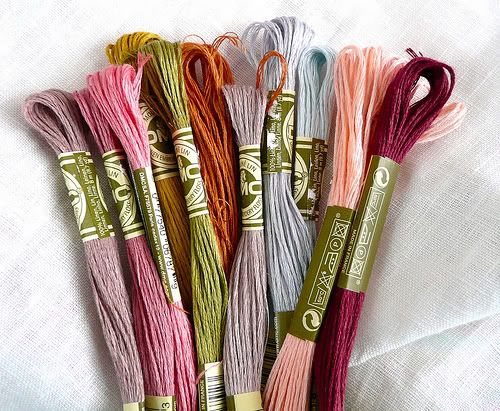Over the years, I’ve seen some really amazing sculpted braids. My hat goes off to those artists as they are far braver and/or more patient than I am. I’ve tried it, but the strands always break on me or get blobby or turn into a giant mushy mess.
So I prefer the floss technique:
Required Reading
“Brands I Prefer: Everything Else”
“Brands I Prefer: Clay”
Ingredients
3 strands of DMC Floss
Fray Check
Super glue
1 oz Apoxie
I use this same basic technique for many types of braiding from backyard ponies to full hunter braids. Today, I’m going to show you dressage braids because they are the easiest type to start out.
Despite how disciplined dressage is overall, my understanding is that the rules for grooming are somewhat lax. Tails are loose. Manes are braided, but they don’t have to include an exact number to correspond to their gender or whatever it is they do for hunter shows these days. If you haven't already, I suggest you take a quick detour over to Jennifer Buxton's post on dressage braids to get an idea of the variety. I'll wait.
.
.
.
.
.
...All done? Let's move on to our model. This guy was handed to me already braid-free, so now I need to put some back on:
I start with three 12inch (-ish) strands of DMC Floss. Yup, that's the same bright colored thread used for embroidery and arab costumes.
*+*+*+* Pretty colors! *+*+*+*
My preference is for the brightest and tackiest colors I can find, especially when electric blue or day-glow orange is on sale that day at Michaels.
I use my three strands to make a basic braid.
I find it easier to braid when I loop the floss around a convenient toe, but only when I have one on hand.
I end the braid with a small dot of super glue.
This is where my fray check will first come into play. I'm not really sure what's in it, but it's basically a low viscosity glue that fabric (and by extension DMC floss) is very eager to absorb. I apply a layer--inch by inch--of fray check to the entire length of the braid.
I lightly rub it into the braid, which means my fingers are covered in glue for the rest of this tutorial.
Set the braid aside to dry.
When dry, I start fiddling with the braid to determine how to twist it to get the size and shape I want. For this one, I wrapped it over itself once, then tied it tight with a separate thread.
I trim off all the extra thread and floss until I'm left with just an itty-bitty braid. This step is why I favor obnoxious colors as lime green is a thousand times easier to locate when I drop it on the carpet than light tan. From here, I glue the braid directly to the model's neck.
For the last braid on the base of the neck and for the forelock, I try to make slightly smaller braids to reflect the thinner areas of hair at the wither and in the forelock.
When I'm happy with the number and placement of the braids, I add a small drop of fray check on top of each braid and let it dry. The goal here is harden the floss so it approximates the rigidity of dried Apoxie. Sometimes this takes a few additional layers. I finish the braids by adding a small spot of clay above each braid. With my trusty sculpting tool, I sculpt the clay into small triangle shapes and blend into the neck.


















8 comments:
Thank you for this tutorial. Someone CMed a Breyer SM pony for me and they did tiny braids on her. She's the only CM I own and I love her. The tiny braids always fascinated me.
I've used this method myself and just wanted to tell you that I too, use my faithful ole toe!
That was so darn easy it never would have occurred to me to do it that way. Thanks!
And I love your leopard print PJs.
I'd love to see pictures of you adding epoxy- to me that seems like the hardest part, where I would still get big old blobs. Have you ever tried just gessoing or thick painting over the floss? That's where I thought this tutorial was headed, actually.
Gah, this is brilliance! Thank you so much for sharing! I've got a couple of customs in progress that I'd like to give plaits to. :D
OH OH OH OH OH MY GODDESS!!
I have a CM commission that one of the very next steps in the upcoming week is braids - I was DREADING it! Talk about perfect timing. Your techniques are just so simple yet effective.
One question though .... there is usually mane in between the braids that is stretched out to each braid. Is this something that is normally sculpted in?
this is totally awesome - I'm so stoked! thank you!
@Beth - There is and I will follow up with another tutorial on how I sculpt it in a few weeks.
Wow, that easy! Thank you for showing how to make braids! :)
Post a Comment